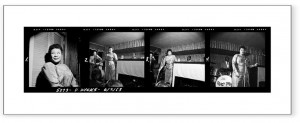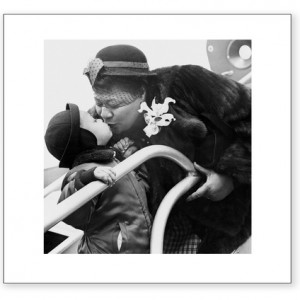Metronome Magazine: Ella Fitzgerald
(April 25, 1917 – June 15, 1996)
American jazz vocalist often referred to as the “First Lady of Song,” the “Queen of Jazz” and “Lady Ella,” she was noted for her purity of tone, impeccable diction, phrasing and intonation, and a “horn-like” improvisational ability, particularly in her scat singing and vocal range spanning three octaves.
Over the course of her 60-year
recording career,
Ella sold 40 million copies of her
70-plus albums,
won 13 Grammy Awards
and was awarded the
National Medal of Arts
and the
Presidential Medal of Freedom
Fitzgerald made her singing debut at age 17 on November 21, 1934, at the Apollo Theater in Harlem, New York. She pulled in a weekly audience at the Apollo and won the opportunity to compete in one of the earliest of its famous “Amateur Nights.” She had originally intended to go on stage and dance, but, intimidated by the Edwards Sisters, a local dance duo, she opted to sing instead and won the first prize of US $25.00.
In January 1935, Fitzgerald won the chance to perform for a week with the Tiny Bradshaw band at the Harlem Opera House where she met bandleader and drummer Chick Webb. Webb was reluctant to sign her because he felt she was gawky and unkempt, but at the insistence of his band members Webb offered her the opportunity to test with his band at a dance at Yale University. She was immediately hired and began singing regularly with his orchestra throughout 1935 at Harlem’s Savoy Ballroom. Together they recorded several hit songs, including “Love and Kisses” and “(If You Can’t Sing It) You’ll Have to Swing It (Mr. Paganini).” But it was their 1938 version of the nursery rhyme, “A-Tisket, A-Tasket”, a song Ella co-wrote, that brought Ella and the band wide public acclaim.
When Webb died on June 16, 1939, the band was renamed Ella and her Famous Orchestra with Fitzgerald taking on the role of nominal bandleader. Ella went on to recorded nearly 150 songs with the orchestra before she broke up the band in 1942 to begin a solo career. She had several popular hits while recording with such artists as Bill Kenny & the Ink Spots, Louis Jordan, and the Delta Rhythm Boys.
With the demise of the Swing era and the decline of the great touring big bands, a major change in jazz music occurred. The advent of bebop led to new developments in Fitzgerald’s vocal style, influenced by her work with Dizzy Gillespie’s big band. It was in this period that Fitzgerald started including scat singing as a major part of her performance repertoire. While singing with Gillespie, Fitzgerald recalled, “I just tried to do [with my voice] what I heard the horns in the band doing.” Her 1945 scat recording of “Flying Home” arranged by Vic Schoen would later be described by The New York Times as “one of the most influential vocal jazz records of the decade….Where other singers, most notably Louis Armstrong, had tried similar improvisation, no one before Miss Fitzgerald employed the technique with such dazzling inventiveness.” Her bebop recording of “Oh, Lady Be Good!” in 1947 was similarly popular and increased her reputation as one of the leading jazz vocalists.
On March 15, 1955 Ella Fitzgerald opened her initial engagement at the Mocambo nightclub in Hollywood, after Marilyn Monroe lobbied the owner for the booking. The booking was instrumental in Fitzgerald’s career.
Ella went on to record with several Jazz greats including three studio albums with Louis Armstrong, bandleaders Count Basie and Duke Ellington (Fitzgerald features on one track on Basie’s 1957 album One O’Clock Jump, while her 1963 album Ella and Basie! is remembered as one of her greatest recordings). Fitzgerald and Basie also collaborated on the 1972 album Jazz at Santa Monica Civic ’72, and on the 1979 albums Digital III at Montreux, A Classy Pair and A Perfect Match.
AWARDS
Fitzgerald won thirteen Grammy Awards, and received the Grammy Lifetime Achievement Award in 1967.
Other major awards and honors she received during her career were the Kennedy Center for the Performing Arts Medal of Honor Award, National Medal of Art, first Society of Singers Lifetime Achievement Award, named “Ella” in her honor, Presidential Medal of Freedom, and the George and Ira Gershwin Award for Lifetime Musical Achievement, UCLA Spring Sing. Across town at the University of Southern California, she received the USC “Magnum Opus” Award which hangs in the office of the Ella Fitzgerald Charitable Foundation. In 1990, she received an honorary doctorate of Music from Harvard University.
Ella Fitzgerald “Welcome Home Ella”
Photographer: David B. Hecht
Year Photo Taken: c. 1952
Photo appeared in Metronome Magazine in the August, 1952 issue on page 27, headline read, Ella Fitzgerald greets an admiring Junior upon her return from Europe.

Ella Fitzgerald “Contact Sheet”
Photographer: David B. Hecht
Year Photo Taken: June 2, 1953
Photos in this contact sheet appeared on the cover of Metronome Magazine in October, 1953 and in the same issue on page 13, in an article entitled, “Ella!” everybody thinks she’s the greatest, except maybe miss Fitzgerald, herself, also appearing in Metronome Magazine in the August, 1955 issue on page 16, and in the Jazz Today Magazine in the May, 1957 issue on page 11 in an article entitled, “First Lady Of Song Ella Fitzgerald.”
Back to Artist List
Back to Metronome Main Page

